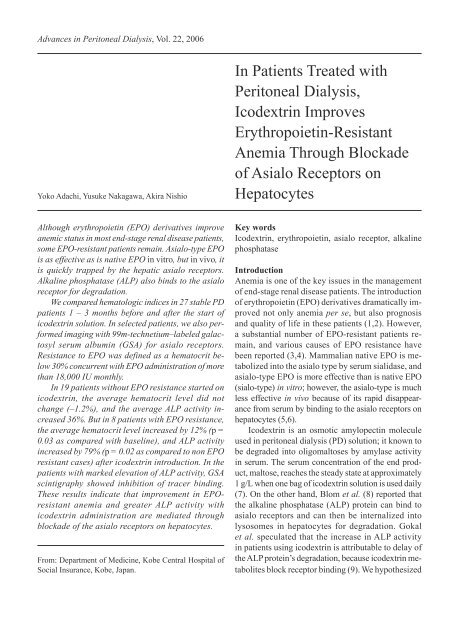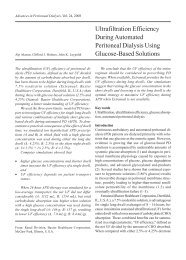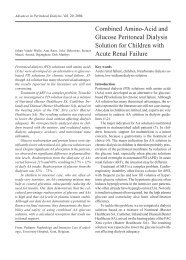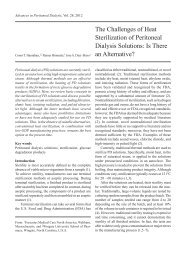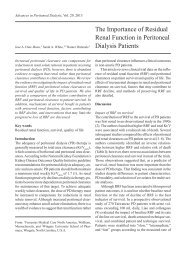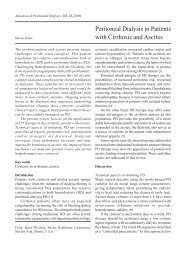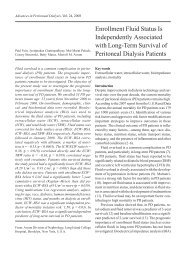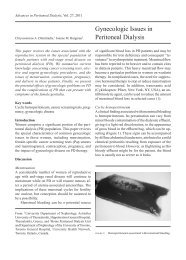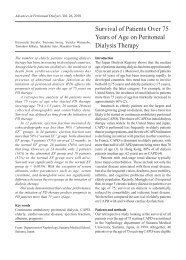109-Adachi final 41.pdf - Advances in Peritoneal Dialysis
109-Adachi final 41.pdf - Advances in Peritoneal Dialysis
109-Adachi final 41.pdf - Advances in Peritoneal Dialysis
You also want an ePaper? Increase the reach of your titles
YUMPU automatically turns print PDFs into web optimized ePapers that Google loves.
<strong>Advances</strong> <strong>in</strong> <strong>Peritoneal</strong> <strong>Dialysis</strong>, Vol. 22, 2006<br />
Yoko <strong>Adachi</strong>, Yusuke Nakagawa, Akira Nishio<br />
In Patients Treated with<br />
<strong>Peritoneal</strong> <strong>Dialysis</strong>,<br />
Icodextr<strong>in</strong> Improves<br />
Erythropoiet<strong>in</strong>-Resistant<br />
Anemia Through Blockade<br />
of Asialo Receptors on<br />
Hepatocytes<br />
Although erythropoiet<strong>in</strong> (EPO) derivatives improve<br />
anemic status <strong>in</strong> most end-stage renal disease patients,<br />
some EPO-resistant patients rema<strong>in</strong>. Asialo-type EPO<br />
is as effective as is native EPO <strong>in</strong> vitro, but <strong>in</strong> vivo, it<br />
is quickly trapped by the hepatic asialo receptors.<br />
Alkal<strong>in</strong>e phosphatase (ALP) also b<strong>in</strong>ds to the asialo<br />
receptor for degradation.<br />
We compared hematologic <strong>in</strong>dices <strong>in</strong> 27 stable PD<br />
patients 1 – 3 months before and after the start of<br />
icodextr<strong>in</strong> solution. In selected patients, we also performed<br />
imag<strong>in</strong>g with 99m-technetium–labeled galactosyl<br />
serum album<strong>in</strong> (GSA) for asialo receptors.<br />
Resistance to EPO was def<strong>in</strong>ed as a hematocrit below<br />
30% concurrent with EPO adm<strong>in</strong>istration of more<br />
than 18,000 IU monthly.<br />
In 19 patients without EPO resistance started on<br />
icodextr<strong>in</strong>, the average hematocrit level did not<br />
change (–1.2%), and the average ALP activity <strong>in</strong>creased<br />
36%. But <strong>in</strong> 8 patients with EPO resistance,<br />
the average hematocrit level <strong>in</strong>creased by 12% (p =<br />
0.03 as compared with basel<strong>in</strong>e), and ALP activity<br />
<strong>in</strong>creased by 79% (p = 0.02 as compared to non EPO<br />
resistant cases) after icodextr<strong>in</strong> <strong>in</strong>troduction. In the<br />
patients with marked elevation of ALP activity, GSA<br />
sc<strong>in</strong>tigraphy showed <strong>in</strong>hibition of tracer b<strong>in</strong>d<strong>in</strong>g.<br />
These results <strong>in</strong>dicate that improvement <strong>in</strong> EPOresistant<br />
anemia and greater ALP activity with<br />
icodextr<strong>in</strong> adm<strong>in</strong>istration are mediated through<br />
blockade of the asialo receptors on hepatocytes.<br />
From: Department of Medic<strong>in</strong>e, Kobe Central Hospital of<br />
Social Insurance, Kobe, Japan.<br />
Key words<br />
Icodextr<strong>in</strong>, erythropoiet<strong>in</strong>, asialo receptor, alkal<strong>in</strong>e<br />
phosphatase<br />
Introduction<br />
Anemia is one of the key issues <strong>in</strong> the management<br />
of end-stage renal disease patients. The <strong>in</strong>troduction<br />
of erythropoiet<strong>in</strong> (EPO) derivatives dramatically improved<br />
not only anemia per se, but also prognosis<br />
and quality of life <strong>in</strong> these patients (1,2). However,<br />
a substantial number of EPO-resistant patients rema<strong>in</strong>,<br />
and various causes of EPO resistance have<br />
been reported (3,4). Mammalian native EPO is metabolized<br />
<strong>in</strong>to the asialo type by serum sialidase, and<br />
asialo-type EPO is more effective than is native EPO<br />
(sialo-type) <strong>in</strong> vitro; however, the asialo-type is much<br />
less effective <strong>in</strong> vivo because of its rapid disappearance<br />
from serum by b<strong>in</strong>d<strong>in</strong>g to the asialo receptors on<br />
hepatocytes (5,6).<br />
Icodextr<strong>in</strong> is an osmotic amylopect<strong>in</strong> molecule<br />
used <strong>in</strong> peritoneal dialysis (PD) solution; it known to<br />
be degraded <strong>in</strong>to oligomaltoses by amylase activity<br />
<strong>in</strong> serum. The serum concentration of the end product,<br />
maltose, reaches the steady state at approximately<br />
1 g/L when one bag of icodextr<strong>in</strong> solution is used daily<br />
(7). On the other hand, Blom et al. (8) reported that<br />
the alkal<strong>in</strong>e phosphatase (ALP) prote<strong>in</strong> can b<strong>in</strong>d to<br />
asialo receptors and can then be <strong>in</strong>ternalized <strong>in</strong>to<br />
lysosomes <strong>in</strong> hepatocytes for degradation. Gokal<br />
et al. speculated that the <strong>in</strong>crease <strong>in</strong> ALP activity<br />
<strong>in</strong> patients us<strong>in</strong>g icodextr<strong>in</strong> is attributable to delay of<br />
the ALP prote<strong>in</strong>’s degradation, because icodextr<strong>in</strong> metabolites<br />
block receptor b<strong>in</strong>d<strong>in</strong>g (9). We hypothesized
42 <strong>Adachi</strong> et al.<br />
that this blockade could be <strong>in</strong>directly proved by imag<strong>in</strong>g<br />
with 99m-technetium–labeled human galactosyl<br />
album<strong>in</strong> ( 99m Tc GSA).<br />
Consider<strong>in</strong>g this background, we found that EPOresistant<br />
anemia improved <strong>in</strong> patients us<strong>in</strong>g icodextr<strong>in</strong><br />
solution. Moreover, those patients simultaneously<br />
showed a greater <strong>in</strong>crease <strong>in</strong> ALP activity than did<br />
patients without EPO resistance. The mechanism of<br />
the improved anemia <strong>in</strong> EPO-resistant patients therefore<br />
seems to reflect blockade of asialo receptors and<br />
delayed breakdown of the ALP prote<strong>in</strong>.<br />
Patients and methods<br />
We analyzed 27 stable patients on PD with icodextr<strong>in</strong><br />
solution. We compared hematologic <strong>in</strong>dices before and<br />
1 – 3 months after the <strong>in</strong>itiation of icodextr<strong>in</strong> solution.<br />
We performed liver imag<strong>in</strong>g with 99m Tc GSA for<br />
asialo receptors <strong>in</strong> 3 patients before and after the use<br />
of icodextr<strong>in</strong>. We def<strong>in</strong>ed EPO resistance as a hematocrit<br />
below 30% with concurrent adm<strong>in</strong>istration of<br />
more than 18,000 IU EPO monthly. Statistical analyses<br />
used the paired or unpaired t-test, and we accepted<br />
p values of 0.05 or less as statistically significant.<br />
Results<br />
Table I shows the changes of hematocrit and ALP activity<br />
<strong>in</strong> patients with and without EPO-resistant anemia<br />
after icodextr<strong>in</strong> use. In 19 patients without<br />
EPO-resistant anemia, the average hematocrit level<br />
did not change significantly (–1.2%), and ALP activity<br />
<strong>in</strong>creased only 36% from the basel<strong>in</strong>e level. On<br />
the other hand, <strong>in</strong> 8 patients with EPO resistance, the<br />
average hematocrit <strong>in</strong>creased 12% (p = 0.03 as compared<br />
with basel<strong>in</strong>e, by paired t-test), and ALP activity<br />
rose by 79% (p = 0.02 as compared with that<br />
<strong>in</strong> patients without EPO resistance, by unpaired t-<br />
test). In the graphs for all 27 <strong>in</strong>dividual patients<br />
(Figure 1), we found no l<strong>in</strong>ear correlation between<br />
the percentage <strong>in</strong>crease <strong>in</strong> hematocrit and ALP activity<br />
from basel<strong>in</strong>e.<br />
Figure 2 shows a representative liver imag<strong>in</strong>g<br />
study by 99m Tc GSA sc<strong>in</strong>tigraphy <strong>in</strong> a patient with<br />
marked elevation of ALP activity. The LHL 15 read<strong>in</strong>g,<br />
which <strong>in</strong>dicates tracer b<strong>in</strong>d<strong>in</strong>g to hepatocytes,<br />
showed a normal value before the use of icodextr<strong>in</strong>;<br />
after icodextr<strong>in</strong> use, it showed moderately impaired<br />
uptake. In patients with a slight elevation of ALP activity,<br />
GSA sc<strong>in</strong>tigraphy showed no apparent change<br />
from the <strong>in</strong>itial imag<strong>in</strong>g performed before icodextr<strong>in</strong><br />
use (Data not shown).<br />
Discussion<br />
In the present study, we show for the first time that<br />
icodextr<strong>in</strong> improves EPO-resistant anemia <strong>in</strong> PD patients.<br />
The possible mechanism seemed to be at least<br />
partly related to an elevation of serum ALP activity,<br />
because the <strong>in</strong>crease of ALP activity <strong>in</strong> patients with<br />
EPO-resistant anemia was significantly higher than<br />
that <strong>in</strong> patients with a hematocrit of 30% or more,<br />
although a l<strong>in</strong>ear correlation between the improvement<br />
<strong>in</strong> hematocrit and the elevation of ALP activity<br />
was not achieved.<br />
S<strong>in</strong>ce the early stages of erythropoiet<strong>in</strong> development,<br />
glyco-moiety <strong>in</strong> the molecule has been regarded<br />
as essential for its <strong>in</strong> vivo activity, because a rapid<br />
disappearance of erythropoiet<strong>in</strong> from serum was observed<br />
when the sialic acid at the end of <strong>in</strong>tact molecule<br />
was removed by sialidase <strong>in</strong> serum (5,6). On<br />
TABLE I Mean hematocrit and alkal<strong>in</strong>e phosphatase (ALP)<br />
activity before and after icodextr<strong>in</strong> use<br />
Hematocrit (%) ALP (U/L)<br />
EPO- Not EPO- Not<br />
resistant resistant resistant resistant<br />
Before 25.7±3.2 34.1±3.7 234±34 236±79<br />
After 28.7±4.5 33.7±4.5 419±<strong>109</strong> 322±147<br />
Change (%) 12 –1.5 79 36<br />
p Value 0.03 NS 0.002 0.002<br />
EPO = erythropoiet<strong>in</strong>; NS = nonsignificant.<br />
FIGURE 1 Changes of alkal<strong>in</strong>e phosphatase (ALP) and hematocrit<br />
(Hct) before and after icodextr<strong>in</strong> <strong>in</strong>troduction (all patients).
Icodextr<strong>in</strong> Improves EPO-Resistance 43<br />
of asialo-form erythropoiet<strong>in</strong>, with a consequent slight<br />
improvement <strong>in</strong> anemia. It might be argued that the<br />
observed elevation <strong>in</strong> hematocrit is attributable to<br />
plasma condensation <strong>in</strong> these patients because of <strong>in</strong>creased<br />
ultrafiltration with icodextr<strong>in</strong>; however, this<br />
explanation is unlikely because other biochemical <strong>in</strong>dices<br />
did not change (Data not shown).<br />
Further studies are warranted to prove whether the<br />
serum level of erythropoiet<strong>in</strong> <strong>in</strong>creases with the use<br />
of icodextr<strong>in</strong> <strong>in</strong> resistant patients. We also need to<br />
clarify why patients with a hematocrit of 30% or more<br />
did not show a further <strong>in</strong>crease <strong>in</strong> that value even<br />
though their ALP level was somewhat higher. And a<br />
last question to be <strong>in</strong>vestigated <strong>in</strong> the future is why<br />
some patients showed a marked <strong>in</strong>crease <strong>in</strong> ALP activity,<br />
but some did not, even though all used<br />
icodextr<strong>in</strong> solution <strong>in</strong> the same way.<br />
Conclusions<br />
Icodextr<strong>in</strong> improved EPO-resistant anemia, and the<br />
mechanism seems to relate to blockade of the hepatic<br />
asialo receptors by icodextr<strong>in</strong> metabolites.<br />
FIGURE 2 Receptor imag<strong>in</strong>g with 99m Tc galactosyl serum album<strong>in</strong><br />
sc<strong>in</strong>tigraphy before (upper panel) and after (lower panel)<br />
icodextr<strong>in</strong> use.<br />
the other hand, as Blom et al. reported (8), ALP prote<strong>in</strong><br />
conta<strong>in</strong>s a galactose moiety at the end of its molecule,<br />
and blockade of the asialo receptor significantly <strong>in</strong>creased<br />
ALP serum activity because of delayed degradation<br />
of the prote<strong>in</strong>. Gokal et al. speculated that the<br />
<strong>in</strong>crease of ALP activity <strong>in</strong> patients us<strong>in</strong>g icodextr<strong>in</strong><br />
solution might <strong>in</strong>volve the same mechanism as that for<br />
icodextr<strong>in</strong> metabolites (9). In prov<strong>in</strong>g this hypothesis<br />
(as shown by 99m Tc GSA sc<strong>in</strong>tigraphy imag<strong>in</strong>g of asialo<br />
receptors), we also demonstrated that only icodextr<strong>in</strong><br />
users with <strong>in</strong>creased ALP activity showed the <strong>in</strong>hibited<br />
receptor b<strong>in</strong>d<strong>in</strong>g. The images suggest that the <strong>in</strong>creased<br />
ALP activity is attributable to blockade of the<br />
hepatic asialo receptors by icodextr<strong>in</strong> metabolites, with<br />
a consequent delay <strong>in</strong> ALP breakdown.<br />
Tak<strong>in</strong>g these f<strong>in</strong>d<strong>in</strong>gs together, we speculate that<br />
blockade of the asialo receptors by icodextr<strong>in</strong><br />
metabolites also caused blockade of the degradation<br />
References<br />
1 Foley RN, Parfrey PS, Harnett JD, Kent GM, Murray<br />
DC, Barré PE. The impact of anemia on cardiomyopathy,<br />
morbidity, and mortality <strong>in</strong> end-stage renal<br />
disease. Am J Kidney Dis 1996; 28:53–61.<br />
2 Pollock CA. The impact of guidel<strong>in</strong>es for the prevention<br />
of anemia on cl<strong>in</strong>ical outcome. Perit Dial Int<br />
2005; 25(Suppl 3):S99–101.<br />
3 Macdougall IC. Poor response to erythropoiet<strong>in</strong>:<br />
practical guidel<strong>in</strong>es on <strong>in</strong>vestigation and management.<br />
Nephrol Dial Transplant 1995; 10:607–14.<br />
4 Macdougall IC. Hyporesponsiveness to anemia<br />
therapy—what are we do<strong>in</strong>g wrong? Perit Dial Int<br />
2001; 21(Suppl 3):S225–30.<br />
5 Takeuchi M, Takasaki S, Shimada M, Kobata A. Role<br />
of sugar cha<strong>in</strong>s <strong>in</strong> the <strong>in</strong> vitro biological activity of<br />
human erythropoiet<strong>in</strong> produced <strong>in</strong> recomb<strong>in</strong>ant Ch<strong>in</strong>ese<br />
hamster ovary cells. J Biol Chem 1990;<br />
265:12127–30.<br />
6 Briggs DW, Fisher JW, George WJ. Hepatic clearance<br />
of <strong>in</strong>tact and desialylated erythropoiet<strong>in</strong>. Am J<br />
Physiol 1974; 227:1385–8.<br />
7 Plum J, Gentile S, Verger C, et al. Efficacy and safety<br />
of a 7.5% icodextr<strong>in</strong> peritoneal dialysis solution <strong>in</strong><br />
patients treated with automated peritoneal dialysis.<br />
Am J Kidney Dis 2002; 39:862–71.<br />
8 Blom E, Ali MM, Mortensen B, Huseby NE.<br />
Elim<strong>in</strong>ation of alkal<strong>in</strong>e phosphatase from circulation
44 <strong>Adachi</strong> et al.<br />
by the galactose receptor. Different isoforms are<br />
cleaved at various rates. Cl<strong>in</strong> Chim Acta 1998;<br />
270:125–37.<br />
9 Gokal R, Moberly J, L<strong>in</strong>dholm B, Mujais S. Metabolic<br />
and laboratory effect of icodextr<strong>in</strong>. Kidney Int<br />
2002; 62(Suppl 81):S62–71.<br />
Correspond<strong>in</strong>g author:<br />
Yoko <strong>Adachi</strong>, MD, Department of Medic<strong>in</strong>e, Kobe<br />
Central Hospital of Social Insurance, 2-1-1, Soyamacho,<br />
Kita-ku, Kobe 651-1145 Japan.<br />
E-mail:<br />
yohkoada@u01.gate01.com


